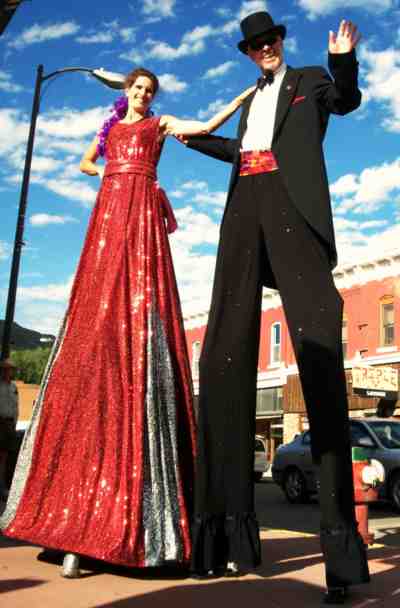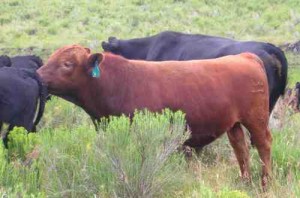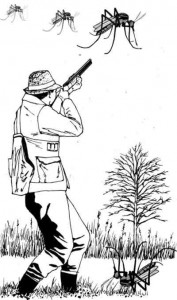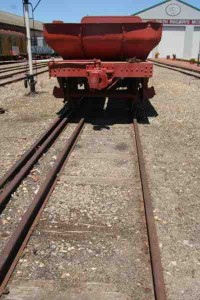Article by Jennifer Dempsey
Recreation – August 2007 – Colorado Central Magazine
WHEN I DROPPED OUT of Queen’s University to join the Belfast Community Circus, I wasn’t being rebellious, I was accepting a different assignment.
It was October ’89 and I had been in Belfast for a month as a junior year abroad student, when I walked out of the Student Union to see a small sign posted on a tree advertising a circus workshop at a nearby church. Ignoring the time and my Irish literature class, I headed over to the church hall where I opened the door to a roomful of kids walking on stilts, trying to juggle, spinning plates, and tossing diabolos.
I told the long-haired Australian man in charge that I had been in a children’s circus club in Virginia. Mike welcomed me in, took me around to meet some of the kids and explained what the Belfast Community Circus was all about.

“We use these circus workshops as a way of bringing kids together,” he said. “Many of these kids would never meet each other except maybe in a sectarian street fight. Here they work together and learn that Catholics don’t have horns and Protestants aren’t cross-eyed. We don’t set out to make these kids circus superstars, but sometimes along the way it happens.”
“Hey Mike! Watch this!” We turned around and saw Paul, a 13-year-old from the Shankhill Road, walk by us on a rolling globe while juggling three clubs.
“Fantastic, my man!” Mike shouted, giving him a high-five.
We moved through the room, darting around a young unicyclist wobbling his way straight towards us.
“Whoa, steady Sean, you’ve got it!” Mike said as Sean pedaled faster and faster before crashing to the ground. Mike gave him a hand up and introduced me.
“This is Jennifer, she was in a circus back in the United States and wants to teach us acrobatics.”
Before I knew it, I was doing a warm-up with some 20 kids, eager to learn the double crab, the triple window and caterpillar walk, tricks I had learned back in Virginia at the Oak View Youth Circus.
That was the beginning of my 12-year career with the Belfast Community Circus. I told the lady at the junior year abroad office that I was dropping out of Queen’s to work with the local community circus. She was totally baffled and wanted me to explain, but I didn’t want to go into the “different assignment” thing with her; besides I had a gymnastics workshop starting shortly in East Belfast .
I also taught unicycling, trapeze, ladder act, contortion and quartet adagio in workshops all around Northern Ireland. I learned stilt-walking, Spanish web, knife juggling and body-balancing, and performed with acts throughout Ireland and the United Kingdom. I worked with kids who were Protestant, Catholic, Republican, Loyalist, British, Irish, working-class and middle-class. I worked with kids whose parents were in jail for paramilitary activity and kids whose parents had been killed by paramilitaries. Sometimes these kids were in the same workshop.
I learned through the Belfast Community Circus that no matter what their background, kids are kids are kids, and they all basically want the same thing: to feel safe, to have fun and to show off. Through that circus, I witnessed how community arts could do more for healing hearts and minds in a troubled society than any political peace process.
Fast forward 18 years later.
It was June 20, 2007, the third day of the Salida Circus Camp and also, I realized, World Refugee Day. As I headed over to the Salida Yoga Center to meet the 25 kids enrolled in the camp, I suddenly had an idea. I told the other three tutors to get the kids warmed up while I ran back home and grabbed the brochure from the Afghanistan Mobile Mini Children’s Circus, a circus school in Kabul that had contacted me last year about setting up an exchange.
I got back to camp just as the kids were finding their partners to practice double crab, circus wave and wheel barrow walking.
“Hold on everybody! Have a seat for one second, I want to show you something.” I told them about the kids in Afghanistan who were also learning the double crab and wheel barrow walk. I passed around the brochure showing the Afghan kids practicing pyramids in the desert, the girls stilt-walking wearing head scarves, the crowds sitting in ruins of rubble, laughing at the antics of the kids clowning around.
“Look! They’re doing the name-game just like we did at the beginning of camp,” I said pointing at a picture of 30 kids standing in a circle holding hands.
“What are their names?” asked Melody, an 11 year old acrobat and stilt walker.
“Good question, why don’t we find out?” I suggested.
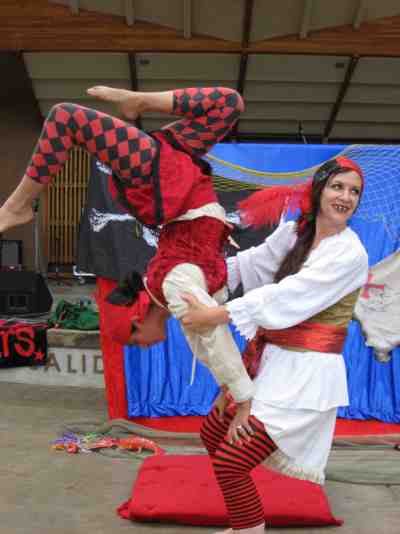
So for the next half hour, the Salida Circus kids wrote letters to the Afghan circus kids, asking them their names, how old they were, what their favorite circus trick was, whether or not they got nervous before a show, and other things kids experience in a circus school. The Salida kids told them what they were learning at circus camp, what their favorite trick was and how they had a big show coming up for the 4th of July.
As we resumed our practice and the kids found their acrobatic partners, I thought about the lady at Queen’s University. I couldn’t explain to her why I was dropping out of college to join a community circus. Maybe I wasn’t sure myself then. But eighteen years later, as I collected letters from the Salida circus kids written to give the Afghan circus kids, I was positive why I had, and building a community circus is one assignment I never want to complete.
Unexpected Results
According to Albert Einstein, insanity is doing the same thing over and over, expecting different results. This must be why circus people have a reputation for being a little crazy. For three months this kid had been trying to get his cartwheel and for three months the same thing would happen.
“Just remember it’s hand, hand, foot, foot,” I would tell Travis each week at the Salida Circus kids’ workshop. His brother, the other eight kids, and I would watch with bated breath as 5-year-old Travis (actually “Twavis” if you asked him) would step out onto the mat, raise his arms over his head, stand with feet astride, and sway back and forth.
“Hand hand foot foot,” I repeated. We’d all be quiet as we watched him concentrate, swaying slowly and methodically. Then in a sudden fling, he’d hurl himself heels over head, and land in a crumpled heap on the mat. We’d all tell him “good job” as he’d pick himself up, brush himself off, and get back in line to try it again.
“Don’t worry, Travis, you’ll get it,” I’d tell him. To be honest, it didn’t look like Travis was getting it. I didn’t know if he’d ever get it, but he didn’t seem the least bit worried.
“Okay everybody, let’s move on to plate-spinning.” As the kids scrambled and fought over who got which plate, I mulled over some of the quirky findings from my own 25 years in circus life.
One thing I have come to understand is that “getting” the trick isn’t always a comfortable thing. Attaining a new skill expands who you are and that can be overwhelming. A minute ago you were someone who couldn’t do a cartwheel and now you are someone who can do a cartwheel — so what does that mean? What else can I do that I don’t know about? Where are my boundaries now?
I doubted Travis was thinking any of this when he came to circus class, but then neither had I when I started circus training back in Virginia. I was nine when I first started trying to do a side aerial. I tried and tried and tried and then one day, when I was ten and wasn’t even trying, I did it. I did a no-handed cartwheel and landed on my feet! I couldn’t believe it. My circus coach couldn’t believe it. The other kids couldn’t believe it. I was ecstatic and exhilarated and as everybody hugged me, I burst into tears and didn’t know why. Maybe that’s why they call it a “circus family.”
This circus class, this practice space, can be a safe place where we test our boundaries and expand ourselves. Our circus mates are there to support us as we try, fail, and sometimes hardest of all, succeed.
It was almost five o’clock.
“Okay everybody, put the plates back in the bag and find a space for final stretches.” As the kids raced to put the plates away and find a space on the floor, I saw a small body hurl himself down the mat — and land on his feet.
“Travis! What was that?!” I hollered. Travis froze where he landed and looked at me startled. The other kids looked around startled. A circus mom who had just arrived looked startled.
“Do that again, quick!” I told him.
Travis backed up on the mat, raised his arms over his head, swayed back and forth and — hand, hand, foot, foot — did a cartwheel!
“Travis! You did a cartwheel! Do it again!”
Wide-eyed and with a stunned look on his face, Travis ran back to the front of the mat and, with the whole class watching did a cartwheel, and then another and another, and even another. The class burst into applause and his brother ran over and hugged him. Travis looked shell-shocked, teary-eyed, and happy as his brother ran to tell his Dad what Travis had just done.
As parents arrived, I swept the floor, feeling excited about the Salida Circus kids trying things like cartwheels and plate-spinning, aerials and juggling, stilt-walking and trapeze, unicycling and diabolo, contortion and body-balancing — things they’ve never tried before — and they can try and try and try again, until like Travis, just when they think they’ll never get it, they’ll surprise themselves with unexpected results.
Jennifer Dempsey is founder of the Salida Circus School. You can catch the Salida Circus at the Chaffee County Fair, Saturday, August 4th. Salida Circus workshops for 4-14 year olds are held at the Salida Yoga Center, 112 F St, on Thursdays from 4-5 p.m. Circus for Grown-Ups will start in September. For more information go to www.salidacircus.com.

